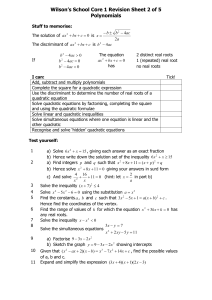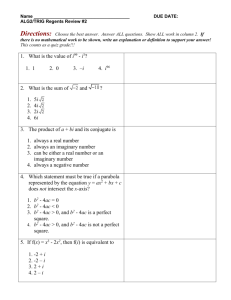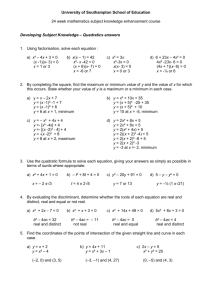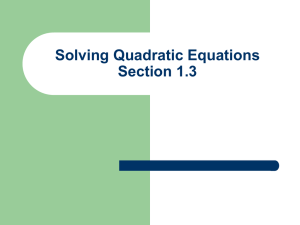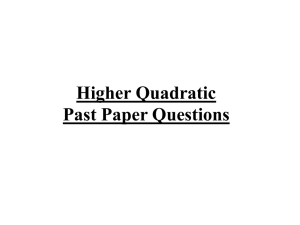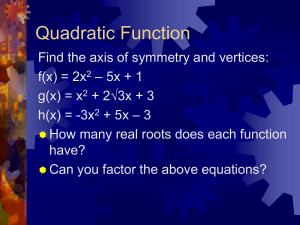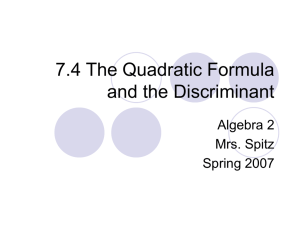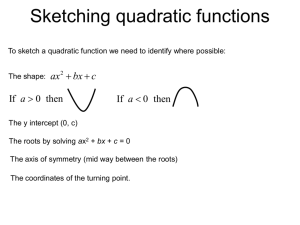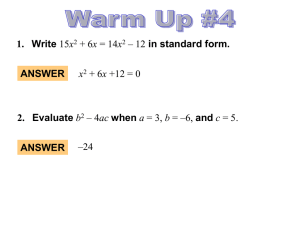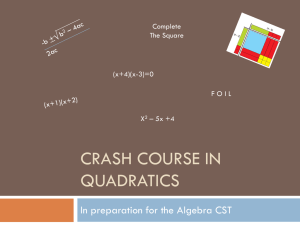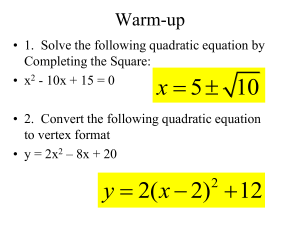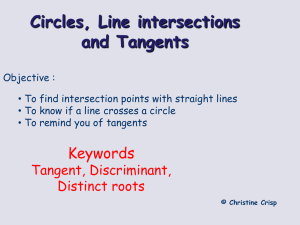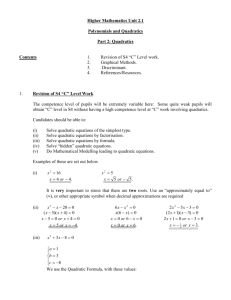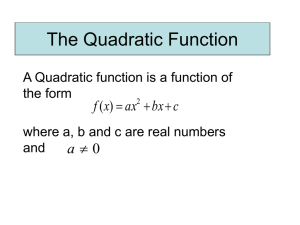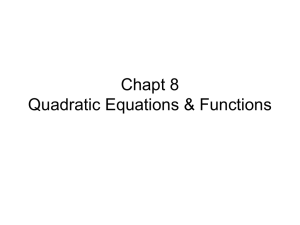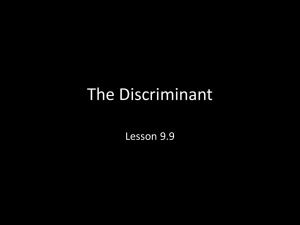Quadratic Theory - Bearsden Academy
advertisement
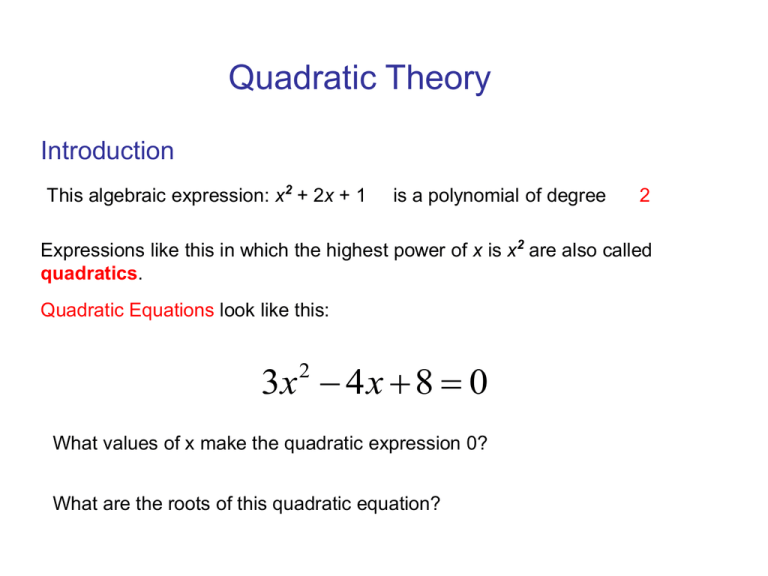
Quadratic Theory Introduction This algebraic expression: x2 + 2x + 1 is a polynomial of degree 2 Expressions like this in which the highest power of x is x2 are also called quadratics. Quadratic Equations look like this: 3x 4 x 8 0 2 What values of x make the quadratic expression 0? What are the roots of this quadratic equation? Solving Quadratic Equations Quadratic equations may be solved by: Factorising Completing the Square Using the quadratic formula Solve x2 – 2x – 8 = 0 using each of the above methods Factorising x2 2 x 8 0 ( x 4)( x 2) 0 x 4 or x 2 When factorising quadratics check for: common factors difference of 2 squares double brackets Completing the Square x 2x 8 a( x b) c 2 2 1.( x 1) 1 8 2 ( x 1)2 9 ( x 1)2 9 0 ( x 1) 9 2 x 1 3 or x 1 3 x 4 or x 2 Using the quadratic formula Reminder: ax2 bx c 0 x2 2 x 8 0 the roots are b b 2 4ac x 2a (2) (2) 2 4.1.(8) x 2.1 2 36 x 2 x 4 or x 2 b2 4ac The Discriminant Equation 864210 54321– 1 Solve x2 – 6x + 8 = 0 x x2 – 6x + 9 = 0 6 36 108642 32 54321– 1 2 3 1 x –1 Roots x 6 36 108642 36 54321– 1 2 3 0 y y Sketch x2 – 6x + 10 = 0 y 10 10 10 8 8 8 6 6 6 4 4 4 2 2 2 1 2 3 4 x = 2 or x = 4 5 x –1 6 36 40 2 4 3 2 1 2 x=3 3 4 5 x –1 1 2 x=? 3 4 5 x As we can see from the above examples, the nature of the roots of a quadratic can be found using the discriminant b2 4ac If b2 4ac 0 If b2 4ac 0 If b2 4ac 0 there are two distinct roots there are two identical roots (i.e. one root) there are no real roots Examples: Tangents to Curves To determine whether a straight line cuts, touches or does not meet a curve the equation of the line is substituted into the equation of the curve. When a quadratic equation results, the discriminant can be used to find the number of points of intersection. Two Points of Intersection y x2 5x 4 meets y x 1 where y x2 5x 4 x 1 4 3 2 1 –4 –3 –2 –1 1 x x2 4 x 3 0 cp. w. ax2 bx c 0 –1 –2 –3 a 1 b 4 c 3 b2 4ac 16 12 b2 4ac 0 2 distinct real roots 2 distinct points of intersection One Point of Intersection y x2 5x 4 meets y x where y x2 5x 4 x 4 3 2 1 –4 –3 –2 –1 1 x x2 4 x 4 0 cp. w. ax2 bx c 0 –1 –2 –3 a 1 b 4 c 4 b2 4ac 16 16 b2 4ac 0 1 real root 1 point of intersection Line is a tangent to the curve No Points of Intersection y x2 5x 4 meets y x 1 where y x2 5x 4 x 1 4 3 2 1 –4 –3 –2 –1 1 x x2 4 x 5 0 cp. w. ax2 bx c 0 –1 –2 –3 a 1 b 4 c 5 b2 4ac 16 20 b2 4ac 0 no real roots no points of intersection The line and the curve do not intersect Examples involving Tangents to Curves: Quadratic Inequalities A quadratic inequality is an expression such as: 3x2 5x 64 0 The problem is to find the values of x for which such an expression is true A quadratic inequality can be solved using a sketch of the quadratic function We can then easily see where the graph is positive or negative. 515 10 21– 4321 Find the values of x for which: a) 12 5 x 2 x 2 > 0 b) 12 5 x 2 x 2 < 0 y 15 First sketch the curve. y intercept at: (0,12) 10 5 x intercepts at: (1½ ,0) and (-4,0) –4 –3 –2 –1 a) From the graph 12 – 5x – 2x2 is positive (i.e. above the x axis) when -4 < x < 1½ b) From the graph 12 – 5x – 2x2 is negative (i.e. below the x axis) when x < -4 or 1½ < x 1 2 x Examples involving solution of Inequalities:
